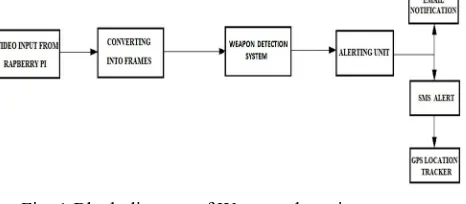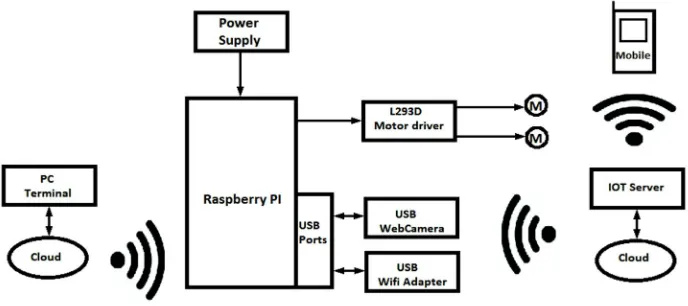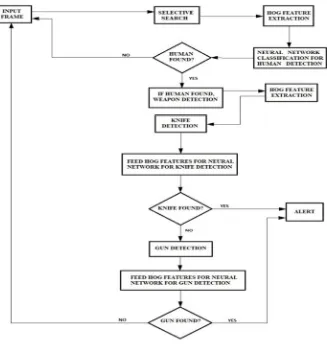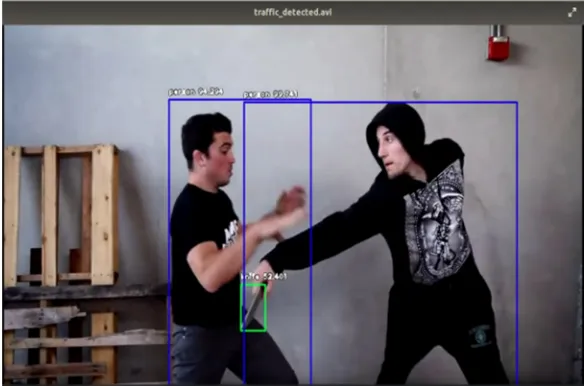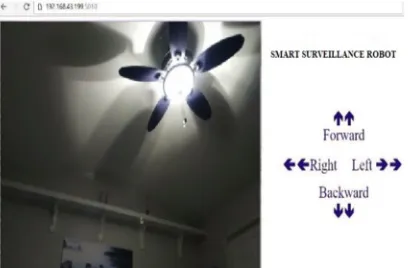©IJRASET: All Rights are Reserved
193
Smart Surveillence Robot for Weapon Detection
Savitha Acharya N1, Vaishnavi M2, Sujith Kumar V3, Shahid Raza4, Halesh M R.5 1, 2, 3, 4, 5
Dept. of Electronics and Communication, Jayachamrajendra College of Engineering, 570018, Mysuru, India
Abstract: The present day surveillance and control systems still require human supervision and intervention. Also most of the surveillance systems are static and are used to monitor only limited area (CCTV). Hence we need a dynamic, robust system which can detect and alert about hand-held weapons (such as pistols and knives) and also the system needs to be mobile. This work presents a novel smart surveillance system which consists of a robot that is used for streaming live videos and can be remotely controlled .This is accomplished through the use of Raspberry-pi which controls the robot streaming the live video and artificial neural network trained to determine the presence of a threat. We reformulate this detection problem into the problem of minimizing false positives and solve it by building the key training data-set guided by the results of a neural network classifier.
Histogram of Gradients (HOG) features have been chosen for the feature extraction phase and the extracted features are fed to neural network with a few hidden layers to achieve detection. Once the weapon has been detected , the system generates an alert message and automatically sends an alert message to the designated phone number. This system also aims in reducing the real-time processing real-time to deliver almost lag-free experience.
Keywords: Surveillance system, neural network, raspberry pi, machine learning
I. INTRODUCTION
With the rapid growth of industry and advancement of technology, it has led to the development of security awareness hence the embedded system society have a higher demand for security and surveillances. It is quite challenging to develop a surveillance and monitoring systems as the systems needs to be designed in a way that it must suit the region to be monitored. The majority of scientific research institute and manufacturers have attached more importance to the design of intelligent security and surveillance system for improving monitoring capabilities and securities of the office and remote places.
For instance, in the defence domain, the military has an ongoing interest in reliably detecting the firing of small arms and weapons. The most commonly used system for security is CCTV monitoring system which has now become an indispensable system in today’s society.
Although CCTV can record video and help the authorities to identify the cause of an incident such as crime, it is just a passive monitoring device which needs 24/7 monitoring by a person. Since everything is becoming smart, there is a need for smart surveillance as well. Generally an efficient surveillance system needs to have certain dynamic features.
In order to monitor a large area it’s a challenging task for security personnel, as a lot of time is spent on patrolling the place. Hence there is a need for designing a smart, active, a good surveillance system which is capable of identifying the context of scene being monitored, has dynamic features and also provide a notification or alarm to the concerned authorities rather than passive recording 24/7.
Similarly, 26/11 Mumbai terror attack demanded us a surveillance system which could have provided a better security helping to save more lives. Considering the images obtained from railway station where person carrying gun was captured, there was a need for a system that would be able to provide alert for security operators helping them to take the situation under control before major damage was done. Also for military counter attack operation where the armed forces have to counter attack by identifying the location of the person with the armed weapons where direct human intervention is risky, there is a need for unmanned devices such as robots that can be controlled from a remote location which can automatically detect a person carrying weapon and also identify his location and alert the concerned authorities. Hence we have proposed a dynamic, robust system which can detect and alert about a person carrying weapon using the concepts of artificial neural network and also which can be controlled from a remote location over the network.
©IJRASET: All Rights are Reserved
194
II. WORKINGPRINCIPLE
The block diagram of the developed closed-loop weapon detection system is illustrated in Figure 1, describing the composition and interconnection of the system.
This is the internet of things (IOT) based project , where we have built a robotic car setup with Robot chassis and 2 DC motors, controlled by a popular micro-computer ie Raspberry Pi and a USB web camera. A web camera is mounted over the robotic car, this is used to provide the live video feed as the robot moves, the important part here is that the robot can be controlled and moved using a web browser over the internet. Since a webpage is used to control the robot, it means that any other smart devices can be used to control it using the webpage.
[image:2.612.195.428.325.427.2]A webpage has been designed using HTML in such a way that on one side it displays the video feed, along with which there are control options for forward, backward, left and right, by clicking on which we can move the robot in any specific direction as per our need. Her we have used a free Linux based, motion detector software application called “Motion” for getting live Video information using USB web camera, a python based micro web framework called “Flask” is used to obtain the commands from the web page and send it to Raspberry Pi, based on these commands the robot is controlled using the python script. The web camera is used to steam the live video of the surrounding region of the robot over the network and can be viewed from the required device, the device can be anything i.e a laptop, tablet or mobile. At the user end a person can view the live video on the monitor. As per the required movement for a specific distance the user can control the robotic car using the web page from the user end. Hence this model acts as smart robot interfaced with a micro-computing device which acts a web server. Along with the above functionalities a GPS module is used to get continuous tracking of the robot’s location.
Fig. 1 Block diagram of Weapon detection system
In this way this surveillance robot can provide accessibility to the regions that cannot be easily accessible to human and also to the place where human intervention is not possible.
This also acts as an alternative to the CCTV cameras that are fit at only a particular place. The video feed obtained is continuously processed in-order to detect if a person carrying a weapon i.e knife or firearm is detected. This is done by using several accurate machine learning models which have ability to locate and localize multiple objects. For this purpose we have used an open source frame work which is built on top of TensorFlow called TensorFlow Object Detection API which provide an easy way to train and construct object detection models. Using this API we have built a model which can detect the presence of a person and if the person possesses any harmful weapon like knife or firearm a SMS notification is sent to the concerned authority. In order to send the SMS notification we have used Twillio API.
Summarizing the above points the system implemented provides a continuous surveillance of the required region through a surveillance robot which can be continuously be tracked and controlled over internet and is able to send an alert notification to concerned authority if a person with harmful weapons is detected.
The knife detection algorithm is based on visual descriptors and machine learning.
©IJRASET: All Rights are Reserved
195
III. DESIGNANDIMPLEMENTATION
A. Hardware Methodology
[image:3.612.135.479.177.330.2]The Surveillance Robot hardware setup consists of Raspberry Pi, Web camera, L293D motor driver, GPS module, power supply. This system can be divided into 2 main units one is the robotic car unit and another a remote controlling unit. The robotic car unit consists of Raspberry Pi, the webcam, motor driven IC, GPS module, DC motors and power supply unit. The remote controlling unit consists of Raspberry Pi, used to provide a control wireless network which is connected to the mobile hotspot and web based controlling of the robot.
Fig. 2: Block diagram of the proposed system
Raspberry Pi is used for wireless and web based controlling of robot. For this purpose we need to setup up operating system of Raspberry Pi ie the Raspbian OS. To perform the necessary actions the required packages are suitably installed using the commands in the raspberry pi terminal. A GPS module is used to continuously get the location of the robot.
A 5 MP Webcam is interfaced to the Raspberry Pi through its USB port which is used to capture the images or videos and then transmit it wirelessly over the internet through raspberry pi which is connected to the mobile hotspot to the web page designed, by observing which the user can easily and conveniently control the robot’s movement. Further this video streaming, controlling can be done from any specific network by enabling port forwarding and the real time streaming can be obtained.
In order to obtain the live video streaming an open source surveillance software called “Motion” is used. As soon as the motion is detected the video recording gets started. With the help of this application one can view the live video streaming on the web browser by typing the IP address of Raspberry pi and the particular port number of video streaming. It can also take snapshots, record and save the videos once motion is detected. Currently only USB camera is supported by Motion.
The web page is designed using mark-up language HTML, which provides the front end interface to the user to control the robot, it has the design to display the video, provide controls like left, right, forward, backward. For the back end controlling we have used a light weight micro web framework, called “Flask” which is used for creating webserver. It provides a means of communication to send and receive commands from webpage to Raspberry Pi. Using Flask one can send and receive data from web browser to Raspberry pi and vice versa and also helps in running the python scripts. Based on the obtained commands and the code for the robot the direction of the DC motors is controlled by L293D IC.
B. Software Methodology
1) Inpur Frame: The Raspberry pi is used to obtain the video input which is controlled through a web server. The video is processed frame by frame and each frame is fed as input to the system.
2) Selective search(segmentation): The input image is too big for model to extract features and process. Thus, segmentation is performed using selective search and can segment, given out as result, is processed. This method is crucial because, extracting features of the whole frame would give us global features, which would not be that efficient in detection process. Hence segmentation is performed to extract the local features. Selective search involves three steps:
a) Generate initial sub-segmentation based on different criteria like color, texture, brightness etc.
b) Recursively combine similar regions into larger ones.
©IJRASET: All Rights are Reserved
196
C. Feature Extraction
Once selective search is performed and segment is extracted. Features are extracted for the given segment, HOG feature extraction involves 4 major stages:
1) Gradient Computation: The first step of calculation is the computation of the gradient values. The most common method is to
apply the 1-D centered, point discrete derivative mask in one or both horizontal and vertical directions. Specifically, this method requires filtering the color or intensity data of the image with the following filter kernels: [-1, 0, 1] and [-1, 0, 1]T. Even Sobel masks can be used for this. These three steps are performed in computing gradients:
a) Find horizontal and vertical edge directions : Ix and Iy .
b) Find gradients |G| = root( Ix2 + Iy2 )
[image:4.612.144.471.225.569.2]c) Orientation theta =atan( Ix / Iy)
Figure 3: Flowchart of the proposed system
2) Orientation Binning: The second step of calculation is creating the cell histograms. Each pixel within the cell casts a weighted vote for an orientation-based histogram channel based on the values found in the gradient computation. The cell themselves can either be rectangular or radial in shape, and the histogram channels are evenly spread over 0 to 180 degrees or 0 to 360 degrees, depending on whether the gradient is “unsigned” or “signed”. Each pixel has weighted vote depending on theta of gradient |G|. The votes for each cell are piled up into orientation bins.
3) Descriptor Blocks: To account for changes in illumination and contrast, the gradient strengths must be locally normalized, which requires grouping the cells together into larger, spatially connected blocks. Rectangular blocks of either 2X2 or 4X4 are considered.
©IJRASET: All Rights are Reserved
197
D. Neural Network Classification For Human Detection
The extracted HOG features are to be fed to neural network as input. The Multilayer Perceptron Neural Network model is used for training, which has an input layer followed by n number of hidden layers and an output layer. Each layer contains nodes called neurons. This layer is followed by number of hidden layers , which use non-linear activation functions to help in the learning process. The output layer should contain number of number of neurons equal to total number of classes like human, non-human etc. All these layers must be fully connected and each node will be fully associated with the weight. The input should be multiplied with subsequent weight and the sum of all such products should be fed into the node in the next layer. The activation function used in the learning process is Tanh, whose equation is:
f(x) = tanh(x) = (ex – e-x ) /(ex + e-x )
The neutral network is to be built and is to be trained using training dataset. After the training the model has to be used for human detection. After the training testing is to be performed. If human is fund in the current segment, then next part of implantation is executed, else the next frame is to be processed by the system. The segment in which human is detected and a few pixels around the segment is also considered and given to next stage as input.
E. Weapon Detection
In our application, we have chosen knife detection. Thus, we have to train a model for detection of each of knife. The HOG features for human detection is different from those for weapon detection. Hence HOG features are to be extracted again with particular cell size and other specifications. The training and detection processes are explained below.
The segment with human detected is the input to this stage. A Multi-layer perceptron. Neural network model is to be designed and HOG features of images are to be extracted and fed as input to the model and training is done and the trained model is pickled and loaded when a prediction is needed. If weapon is found then the alert is generated
F. Alert
If either of the weapons is found then an alert is generated by the system to get some human help. This alert system is implemented using cloud communication service called Twilio. It generates an SMS and sends it to designate number. We then send the SMS notification to the concerned authorities.
IV. RESULTSANDANALYSIS
This session presents selected the best classification model to evaluate it under the sliding window approach. The classifier is
applied automatically, in steps of 60×60-pixels, to windows of 160×120-pixels of each input image to determine wether it contains a pistol. The whole detection process takes 1,5 seconds in a 640×360-pixels input image. Which is not acceptable for an automatic system such as the one considered in this work. The detection model that makes use of the sliding window approach achieves few
false positives and high precision, however, it obtains alow recall 35% and its execution time is not appropriate for online detection.
[image:5.612.159.451.513.706.2]In next section we will explore an other alternative to further improve performance and speed of the detection process.
©IJRASET: All Rights are Reserved
198
Figure 5: Image of the hardware setupFigure 6: Image of the SMS notification
Figure 7: Image of the webpage used to control robot
Human accuracy testing Accuracy: 93.72%
Confusion matrix
Positive Negative
True 3003 282
False 338 247
[image:6.612.203.407.474.608.2]©IJRASET: All Rights are Reserved
199
Knife accuracy testingAccuracy: 81.23% Confusion matrix
Positive Negative
True 3003 282
False 338 247
V. CONCLUSIONANDFUTURESCOPE
By using this surveillance robotic system a person can easily monitor any given area from a remote location and also control the robot over the internet. This system is highly robust, it can be used in areas where it is difficult for human intervention, for the security forces to monitor a region. Using the processing of live video feed we are able to detect if any person with a harmful weapon like knife or fire arm is detected using the various machine learning algorithms with an accuracy of 93.72% and 81.23% for person and knife respectively. Once a person with the weapon is detected we were successfully able to obtain the SMS alert notification. There are lots of improvements that can be made on the current design and technology and lots of additional feature scan be added. We can use different types of sensor so that we can use robot in different field i.e. Temperature Sensor, Pressure Sensor, Heat Sensor, Position Sensor, Proximity Sensor. A multipurpose robot can be made by wireless network, ranging from surveillance and home security to industrial applications where the user need not be present at the work place in person but can do it from his home itself.
VI. ACKNOWLEDGEMENT
The satisfaction and euphoria that accomplices the successful completion of any task would be incomplete without the mention of people who made it possible. We take the opportunity to express our sincere thanks to following persons without whom this project would not have been possible and whose firm believe in our capabilities and moral boosting to bring out full potential towards the forefront has played a major role in each and every step of our endeavor to success.
We are extremely greatfull Dr. Shankaraiah , Professor and Head of the Department of Electronics and Communication Engineering ,Sri Jayachamarajendra College of Engineering Mysuru.
We specially thank to our guide Halesh M.R , Assistant Professor , Dept of E & C for his kind consent , sustained encouragement, timely valuable guidance ,immense help and co-operation throughout the tenure of the project.
REFERENCES
[1] Monterrosa Diaz, Carlos, Georgios Karapanagos, Glen Mould, Paul Solomon Raynes, and Skyler Alsever. "AWeD: Automatic Weapons Detection." (2017). [2] Grega, Michał, Andrzej Matiolański, Piotr Guzik, and Mikołaj Leszczuk. "Automated detection of firearms and knives in a CCTV image." Sensors 16, no.
1 (2016): 47.
[3] Lai, Justin, and Sydney Maples. "Developing a Real-Time Gun Detection Classifier."
[4] Mayank Dharaskar, Vatan Gupta, and Priyanka Kale.” IOT Based Surveillance Robotic Car Using Raspberry PI.” International Journal of Research in
Engineering and Technology 5, no. 3 (2018): 422-425.
[5] Olmos, Roberto, Siham Tabik, and Francisco Herrera. "Automatic handgun detection alarm in videos using deep learning." Neurocomputing 275 (2018): 66-72.
[6] Chen, Hua-Mei, Seungsin Lee, Raghuveer M. Rao, M-A. Slamani, and Pramod K. Varshney. "Imaging for concealed weapon detection: a tutorial overview of development in imaging sensors and processing." IEEE signal processing Magazine 22, no. 2 (2005): 52-61.
[7] Dinesh, M., and K. Sudhaman. "Real time intelligent image processing system with high speed secured Internet of Things: Image processor with IOT." In 2016 International Conference on Information Communication and Embedded Systems (ICICES), pp. 1-5. IEEE, 2016.
[8] Kaur, Amanjeet, and Lakhwinder Kaur. "Concealed weapon detection from images using SIFT and SURF." In 2016 Online International Conference on Green Engineering and Technologies (IC-GET), pp. 1-8. IEEE, 2016.
[9] Rohit Kumar Tiwari and Gyanendra K. Verma, “A Computer Vision based Framework for Visual Gun Detection using Harris Interest Point Detector”, Elsevier Science Direct, pp 703 – 712, 2015.
[10] Carrer, Leonardo, and Alexander G. Yarovoy. "Concealed weapon detection using UWB 3-D radar imaging and automatic target recognition." In The 8th European conference on antennas and propagation (EuCAP 2014), pp. 2786-2790. IEEE, 2014.
©IJRASET: All Rights are Reserved
200
[12] Dr. Mohamed Mansoor Roomi and R. Rajashankari, “Detection of concealed weapons in X-ray Images using Fuzzy K-NN”, International Journal of Computer
Science, Engineering and Information Technology (IJCSEIT), Vol. No.2, pp 187-196, April 2012.
[13] Zhang, Shuai, Chong Wang, Shing-Chow Chan, Xiguang Wei, and Check-Hei Ho. "New object detection, tracking, and recognition approaches for video surveillance over camera network." IEEE sensors journal 15, no. 5 (2015): 2679-2691,May 2015.
[14] Nascimento, Jacinto C., and Jorge S. Marques. "Performance evaluation of object detection algorithms for video surveillance." IEEE Transactions on Multimedia 8, no. 4 : 761-774, Aug 2006.
[15] Dalal, Navneet, and Bill Triggs. "Histograms of oriented gradients for human detection." In international Conference on computer vision & Pattern Recognition (CVPR'05), vol. 1, pp. 886-893. IEEE Computer Society, 2005.
[16] Felzenszwalb, Pedro F., Ross B. Girshick, David McAllester, and Deva Ramanan. "Object detection with discriminatively trained part-based models." IEEE transactions on pattern analysis and machine intelligence 32, no. 9 (2010): 1627-1645.
[17] Girshick, Ross, Jeff Donahue, Trevor Darrell, and Jitendra Malik. "Rich feature hierarchies for accurate object detection and semantic segmentation." In Proceedings of the IEEE conference on computer vision and pattern recognition, pp. 580-587. 2014.
[18] Prof I.Y.Sheik , Harshal C, Jaya S. Vyawhare, Sampada B.Mqhajan,Rahul S.raut,Wi-Fi Surveillance Robot Using Raspberry Pi, International Journal of Research in Advent Technology (IJART) (E-ISSN:2321-9637),April 2016
[19] Matiolański, Andrzej, Aleksandra Maksimova, and Andrzej Dziech. "CCTV object detection with fuzzy classification and image enhancement." Multimedia Tools and Applications 75, no. 17 (2016): 10513-10528.
